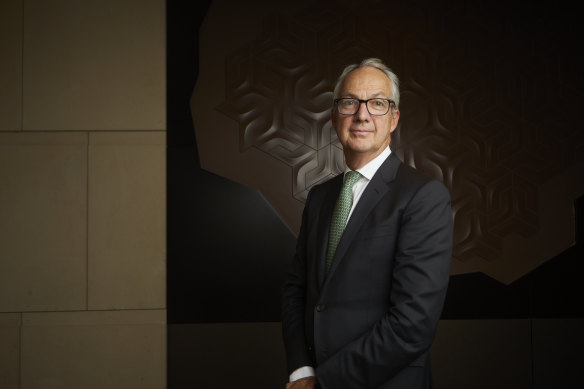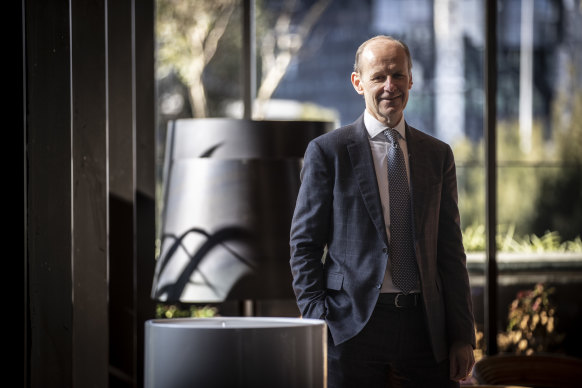
Loading
Although our trade with the region, which has a population of 620 million, has grown over the past two decades, the proportion of total trade has remained constant at around 14 per cent, according to the Moore report. And the big stickler has been investment, which is grossly underweight, accounting for only 3.4 per cent of Australia’s foreign investment.
Moore made 75 recommendations in his report – including appointing 10 of Australia’s leading corporate executives as “business champions” of South-East Asian countries, as well as investor deal teams – to reinvigorate a decades-old push to increase two-way trade and investment in the region.
The recommendations centre on raising awareness, removing blockages to address tariff barriers, building skills’ capability and deepening investment. The government has so far adopted eight of them, and announced a $2 billion investment financing facility to boost investment, but stopped short of underwriting political risk insurance.
It’s too early to say whether the latest report will finally mark a permanent shift within Australian corporations and investors to strengthen their ties with our closest neighbours, parts of which have had a history of political volatility and corruption, and posed sovereign risk to businesses.
Australian businesses have expressed concerns about workplace health and safety, environmental standards and modern slavery risks in some of those South-East Asian countries. They have also been worried that governance and regulatory uncertainty could disrupt their operations.

A year ago, Nicholas Moore handed the government a new report setting out Australia’s south-east Asia strategy.Credit: Natalie Boog
But Moore says Australia could work with ASEAN to develop frameworks to address those issues. He has been travelling in the region to raise awareness with governments and businesses about the opportunities, as well as educating the region about what Australian investors – especially the cash-loaded superannuation industry – are looking for.
“When you look at all the things happening in terms of raising awareness, I think it would have been exceeding expectations.
The business champions are working, the business missions are working. The list of investment projects … and our trade continues to grow with the region when we meet businesses.”
Moore’s list of business champions, includes Linfox chief executive Peter Fox (Thailand), Macquarie chief executive Shemara Wikramanayake (Philippines), and Western Sydney University chancellor Jennifer Westacott (Indonesia).
Another business champion appointed in March, when Australia hosted the ASEAN summit in Melbourne, was Shayne Elliott, the chief executive of ANZ, which celebrated its 50th anniversary in Singapore this month.
Elliot – along with the head of institutional bank, Mark Whelan, and board members Richard Gibb and Christine O’Reilly – visited the small island nation for the first time since his appointment, where he met business and government figures.

ANZ chief executive Shayne Elliott has been appointed the business champion for Singapore.Credit: Arsineh Houspian
“A lot of it is just gathering information and getting the right people in a room,” Elliott says.
“We’ve had a bunch of people in a room where we’ve got together and talked through who is doing what. For example, I engage with a bunch of Australian funds, super funds, corporates who are starting in Asia or keen to start in Asia to hear from them. What would help them make that final step? A lot of it is better understanding and knowledge.”
The ANZ chief says he sees his role as understanding the barriers that businesses and investors are facing as well as sharing success stories of companies that have thrived in Singapore, which he described as a “launching pad for the rest of Asia”.
“What are the big things on Singapore’s mind? Energy security … and they look around and think, who has sustainable long-term access to energy? Australia,” Elliott says.
“Food security. This is a country that doesn’t produce any of its food … Who produces lots of food? Australia. And then digitisation and decarbonisation. There’s only four, but all of those things [make] you sit and go, ‘I can see why there’s a natural alliance with Australia for mutual benefit’.”
Australia’s two-way trade with ASEAN – Indonesia, Vietnam, Laos, Brunei, Thailand, Myanmar, Philippines, Cambodia, Singapore and Malaysia – in 2023 was worth $183 billion (a 2 per cent increase on the year before), accounting for 15 per cent of Australia’s trade. Two-way investment fell 8 per cent to $282 billion.
Australia’s total foreign investment has ballooned 40 per cent in the past five years to almost $4 trillion, mostly concentrated in the United States. But investment in ASEAN over that time contracted 20 per cent to $100 million in 2023, according to Australian Bureau of Statistics figures.
Loading
“Given what happened with COVID, people want to have diversification [away from China],” Moore says.
“We have underperformed in recent years [in South-East Asia] so how do we turn that around?
By telling Australian corporates there’s a great opportunity. You may have been focused on Europe and the US and north Asia, but there are great opportunities here. And saying to institutional investors, yes you’ve invested in major markets but here’s what’s happening with our local neighbours.”
ANZ head of Asia research Khoon Goh said the economic outlook for the continent remained “fairly positive” despite a slump in China’s property sector that had weighed down its economy.
“We’ve seen growth holding up much better in this part of the world,” Goh said. “With the announcement of the stimulus measures [in China that include interest rate cuts and freeing up cash], I think there’s a good chance we might get close to China’s growth this year – their growth target is 5 per cent and we are forecasting 4.9 per cent.
“For the rest of the region, I think the exports continue to do well. The whole AI, the boost for semiconductor demand has really benefited Taiwan, South Korea, and we’re starting to see that benefit the broader region, including Singapore.”
Trade Minister Don Farrell said the government was working to show businesses the “wealth of untapped opportunities” in the ASEAN region.
“More trade, with more trading partners, means more jobs here at home, more opportunities for Aussie businesses and lower prices at the checkout,” Farrell said.
The reporter travelled to Singapore last week as a guest of ANZ.
The Business Briefing newsletter delivers major stories, exclusive coverage and expert opinion. Sign up to get it every weekday morning.









 Add Category
Add Category